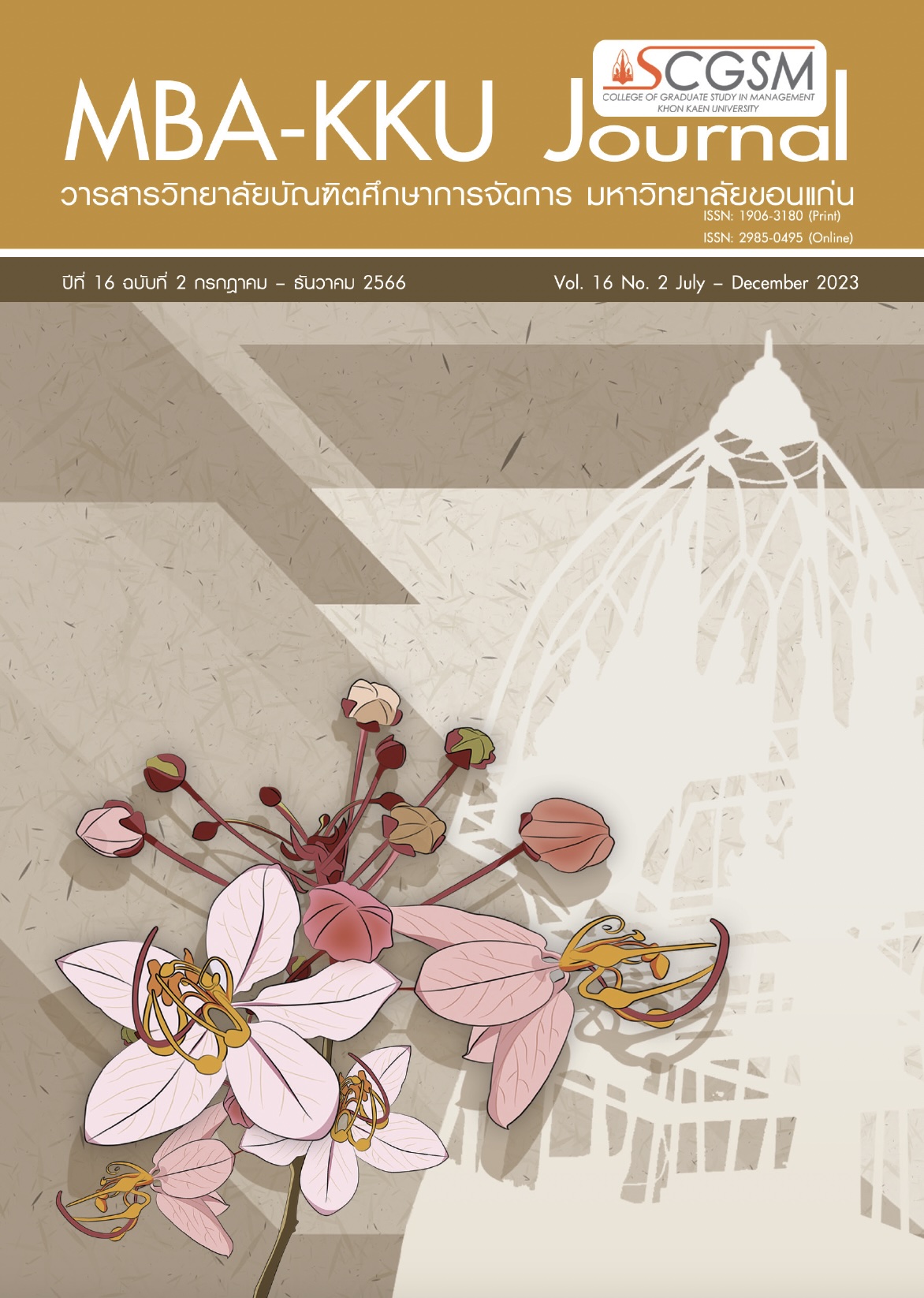The Adaptation Approach in Pharmaceutical Business During the Coronavirus Pandemic 2019 at the Upper Northeastern Thailand: Case Study Evidence of the Smofkabiven (Parenteral Nutrition)
Main Article Content
Abstract
The purposes of this study were to examine 1) the behavior about Smofkabiven peripheral of the doctors, and the marketing mix factors affecting the decision to use Smofkabiven (parenteral nutrition), and 2) setting the approach for maintain sales volume and market share of Smofkabiven at the Upper Northeastern, Thailand. This study adopted a mixed methods research design. Data were collected by using a questionnaire. A sample was select from the 85 doctors from 12 hospitals and interview with 3 medical professors in the field of surgery at the upper of Northeastern, Thailand. The research were analyzed using a statistical analysis (i.e., frequency and percentage). The results revealed that the majority of participants used parenteral nutrition in patient department and the parenteral nutrition provided is Smofkabive. The marketing mix factors affecting the decision to use parenteral nutrition were ingredients in products that are beneficial to patients, product quality, the product has research to support the patient's treatment results, physicians were comfortable ordering or taking medications, providing clear product information, and the product contains documentation and research as well as a reference guideline. The person who influences prescribing was the doctors who supervises the patient. After that, PESTE analysis, Five forces model, SWOT analysis, and TOWS Matrix were analyzed. The finding indicates that online academic activities by using knowledge, medical representative have communication skills to present about quality of products to beneficial for patients will maintain a good relationship with customers and maintain market share and sales.
Article Details

This work is licensed under a Creative Commons Attribution-NonCommercial-NoDerivatives 4.0 International License.
- The ideas and opinions expressed in MBA-KKU Journal are those of the authors and not necessarily those of the editor.
- Copyright on any open access article in a journal published by MBA-KKU Journal
References
กรกต วีรเธียร. (2562). กระบวนการให้โภชนบำบัด. ค้นเมื่อ 17 พฤษภาคม 2564, จาก http://www.thaidietetics.org/wp-content/uploads/2019/04/240462-Lecture-documents-1.pdf
กรมควบคุมโรค กระทรวงสาธารณสุข. (2564). สถานการณ์ โรคติดเชื้อไวรัสโคโรนา 2019. ค้นเมื่อ 25 เมษายน 2565, จาก https://media.thaigov.go.th/uploads/public_img/source/120564.pdf
กฤษฎา ศุภวรรธนะกุล. (2564). ‘ไขข้อสงสัย’ ทำไมบุคลากรสาธารณสุขติดเชื้อ ‘โควิด-19’? ค้นเมื่อ 27 พฤษภาคม 2565, จาก https://www.hfocus.org/content/2020/04/19158
กฤษยา แสงโชติช่วงสุข. (2561). กลยุทธ์การเพิ่มยอดขายธุรกิจจำหน่ายยา บริษัท เอไซ (ประเทศไทย) จำกัด กรณีศึกษา บริษัท เอไซ (ประเทศไทย) มาร์เก็ตติ้ง จำกัด. สารนิพนธ์ปริญญาการจัดการมหาบัณฑิต วิทยาลัยการจัดการ มหาวิทยาลัยมหิดล.
ทิพวรรณ อารียวงศ์สถิตย์ และกฤษฎา มูฮัมหมัด. (2563). พฤติกรรมการซื้อและปัจจัยส่วนประสมการตลาดที่มีผลต่อการตัดสินใจซื้อยาและผลิตภัณฑ์สุขภาพจากร้านขายยาของผู้บริโภคในจังหวัดนครนายก. การประชุมนำเสนอผลงานวิจัยระดับบัณฑิตศึกษา ครั้งที่ 15. (หน้า 928-942). ปทุมธานี: บัณฑิตวิทยาลัย มหาวิทยาลัยรังสิต.
ทีมเศรษฐกิจ ไทยรัฐออนไลน์. (2564). เปิดมาตรการรัฐกระตุ้นเศรษฐกิจ เช็กขุมพลังสู้ศึกโควิดระลอก 2. ค้นเมื่อ 25 เมษายน 2565, จาก https://www.thairath.co.th/business/economics/2018863
นิศาชล ทัพลา และอัจฉริยะ อุปการกุล. (2565). แนวทางการเพิ่มยอดขายออนไลน์ โดยประยุกต์ใช้สุนทรียสาธก: กรณีศึกษา หจก. บิ๊กต้อย 2018. วารสารวิทยาลัยบัณฑิตศึกษาการจัดการ มหาวิทยาลัยขอนแก่น, 15(2), 1-24.
บริษัท เฟรเซนีอุส คาบี (ไทยแลนด์) จำกัด. (2565). รายงานประจำปี 2564. กรุงเทพฯ: บริษัท เฟรเซนีอุส คาบี (ไทยแลนด์) จำกัด.
ปาริชาติ คุณปลื้ม. (2564). การปรับตัวธุรกิจหลังยุค COVID-19. วารสารการเมือง การบริหารและกฎหมาย, 12(2), 99-110.
พรพิมล ทองสุวรรณ. (2561). กลยุทธ์การเพิ่มยอดขายสำหรับธุรกิจเครื่องมือแพทย์ กรณีศึกษา บริษัท โอลิมปัส (ประเทศไทย) จำกัด. สารนิพนธ์ปริญญาการจัดการมหาบัณฑิต วิทยาลัยการจัดการ มหาวิทยาลัยมหิดล.
วรัญญู อิทธิสาร. (2560). กลยุทธ์การจัดการความรู้เพื่อยกระดับศักยภาพงานขายในบริษัทยา. สารนิพนธ์ปริญญาการจัดการมหาบัณฑิต วิทยาลัยการจัดการ มหาวิทยาลัยมหิดล.
วรัทยา กุลนิธิชัย. (2562). การพยาบาลเพื่อติดตามเฝ้าระวังภาวะทุพโภชนาการอย่างต่อเนื่องในผู้ป่วยวิกฤต. วารสารพยาบาลโรคหัวใจและทรวงอก, 30(1), 1-15.
สมนึก ภัททิยธนี. (2560) การวัดผลการศึกษา. พิมพ์ครั้งที่ 10. กาฬสินธุ์: ประสานการพิมพ์.
เอกชัย บุญยาทิษฐาน. (2558). คู่มือวิเคราะห์ SWOT อย่างมืออาชีพ. กรุงเทพฯ: ปัญญาชน.
Hiriyappa, B. (2018). Strategic Analysis. New York: Publish Drive.
Kotler, P. & Keller, K.L. (2017). Marketing Management. 15th ed. Edinburgh: Pearson Education.
Krejcie, R.V. & Morgan, D.W. (1970). Determining sample size for research activities. Educational and Psychological Measurement, 30(3), 607-610.
Porter, M.E. (2008). The Five Competitive Forces that Shape Strategy. Harvard Business Review, 86, 79-93.
Solomon, M.R. (2018). Consumer Behavior: Buying, Having, and Being. Harlow: Pearson.
Thomson, A., Peteraf, M., Gamble, J. & Strickland, A. (2017). Crafting & Executing Strategy: The Quest for Competitive Advantage: Concepts and Cases. 21st ed. New York: McGraw Hill.
Watkins, M. (2016). A start point for Strategy is TOWS not (SWOT). Singapore: Springer Nature.


